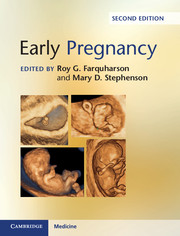25 results
Preface to the Second Edition
-
- Book:
- Early Pregnancy
- Published online:
- 16 February 2017
- Print publication:
- 02 February 2017, pp xi-xii
-
- Chapter
- Export citation
23 - Role of Miscarriage Evaluation
-
-
- Book:
- Early Pregnancy
- Published online:
- 16 February 2017
- Print publication:
- 02 February 2017, pp 229-233
-
- Chapter
- Export citation
Index
-
- Book:
- Early Pregnancy
- Published online:
- 16 February 2017
- Print publication:
- 02 February 2017, pp 325-335
-
- Chapter
- Export citation
Copyright page
-
- Book:
- Early Pregnancy
- Published online:
- 16 February 2017
- Print publication:
- 02 February 2017, pp iv-iv
-
- Chapter
- Export citation
15 - Investigation of Recurrent Miscarriage
-
-
- Book:
- Early Pregnancy
- Published online:
- 16 February 2017
- Print publication:
- 02 February 2017, pp 151-158
-
- Chapter
- Export citation
Plate Section (PDF Only)
-
- Book:
- Early Pregnancy
- Published online:
- 16 February 2017
- Print publication:
- 02 February 2017, pp -
-
- Chapter
- Export citation
Contributors
-
- Book:
- Early Pregnancy
- Published online:
- 16 February 2017
- Print publication:
- 02 February 2017, pp vii-x
-
- Chapter
- Export citation
29 - Chronic Endometritis and Reproduction
-
-
- Book:
- Early Pregnancy
- Published online:
- 16 February 2017
- Print publication:
- 02 February 2017, pp 280-286
-
- Chapter
- Export citation
Contents
-
- Book:
- Early Pregnancy
- Published online:
- 16 February 2017
- Print publication:
- 02 February 2017, pp v-vi
-
- Chapter
- Export citation

Early Pregnancy
-
- Published online:
- 16 February 2017
- Print publication:
- 02 February 2017
12 - Defining Recurrent Pregnancy Loss
-
-
- Book:
- Early Pregnancy
- Published online:
- 16 February 2017
- Print publication:
- 02 February 2017, pp 124-128
-
- Chapter
- Export citation
Contributors
-
-
- Book:
- Clinical Gynecology
- Published online:
- 05 April 2015
- Print publication:
- 23 April 2015, pp viii-xiv
-
- Chapter
- Export citation
Chapter 59 - Recurrent early pregnancy loss
- from Section 8 - Infertility and reproductive endocrinology
-
-
- Book:
- Clinical Gynecology
- Published online:
- 05 April 2015
- Print publication:
- 23 April 2015, pp 918-928
-
- Chapter
- Export citation
Contributors
-
-
- Book:
- The Cambridge Handbook of Applied Perception Research
- Published online:
- 05 July 2015
- Print publication:
- 26 January 2015, pp xi-xiv
-
- Chapter
- Export citation
Chapter 24 - Miscarriage after in-vitro fertilization
-
-
- Book:
- Early Pregnancy
- Published online:
- 05 October 2010
- Print publication:
- 09 September 2010, pp 255-266
-
- Chapter
- Export citation
Preface
-
-
- Book:
- Early Pregnancy
- Published online:
- 05 October 2010
- Print publication:
- 09 September 2010, pp xi-xii
-
- Chapter
- Export citation
Chapter 7 - Investigation of recurrent miscarriage
-
-
- Book:
- Early Pregnancy
- Published online:
- 05 October 2010
- Print publication:
- 09 September 2010, pp 59-66
-
- Chapter
- Export citation
Early Pregnancy - Title page
-
-
- Book:
- Early Pregnancy
- Published online:
- 05 October 2010
- Print publication:
- 09 September 2010, pp iii-iii
-
- Chapter
- Export citation
Contributors
-
-
- Book:
- Early Pregnancy
- Published online:
- 05 October 2010
- Print publication:
- 09 September 2010, pp vii-x
-
- Chapter
- Export citation
Contents
-
- Book:
- Early Pregnancy
- Published online:
- 05 October 2010
- Print publication:
- 09 September 2010, pp v-vi
-
- Chapter
- Export citation



